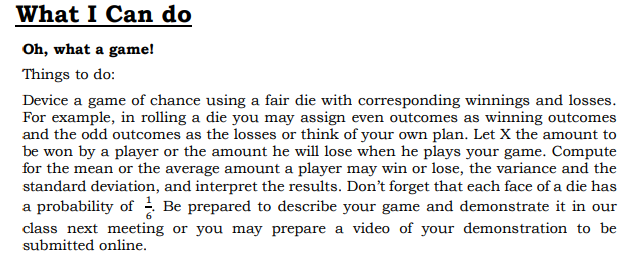Oh, what a game! Things to do: Device a game of chance using a fair die with corresponding winnings and losses. For example, in rolling a die you may assign even outcomes as winning outcomes and the odd outcomes as the losses or think of your own plan. Let X the amount to be won by a player or the amount he will lose when he plays your game. Compute for the mean or the average amount a player may win or lose, the variance and the standard deviation, and interpret the results. Don't forget that each face of a die has a probability of - Be prepared to describe your game and demonstrate it in our class next meeting or you may prepare a video of your demonstration to be submitted online.
Oh, what a game! Things to do: Device a game of chance using a fair die with corresponding winnings and losses. For example, in rolling a die you may assign even outcomes as winning outcomes and the odd outcomes as the losses or think of your own plan. Let X the amount to be won by a player or the amount he will lose when he plays your game. Compute for the mean or the average amount a player may win or lose, the variance and the standard deviation, and interpret the results. Don't forget that each face of a die has a probability of - Be prepared to describe your game and demonstrate it in our class next meeting or you may prepare a video of your demonstration to be submitted online.
Chapter9: Sequences, Probability And Counting Theory
Section9.7: Probability
Problem 4SE: What is the difference between events and outcomes? Give an example of both using the sample space...
Related questions
Concept explainers
Contingency Table
A contingency table can be defined as the visual representation of the relationship between two or more categorical variables that can be evaluated and registered. It is a categorical version of the scatterplot, which is used to investigate the linear relationship between two variables. A contingency table is indeed a type of frequency distribution table that displays two variables at the same time.
Binomial Distribution
Binomial is an algebraic expression of the sum or the difference of two terms. Before knowing about binomial distribution, we must know about the binomial theorem.
Topic Video
Question

Transcribed Image Text:What I Can do
Oh, what a game!
Things to do:
Device a game of chance using a fair die with corresponding winnings and losses.
For example, in rolling a die you may assign even outcomes as winning outcomes
and the odd outcomes as the losses or think of your own plan. Let X the amount to
be won by a player or the amount he will lose when he plays your game. Compute
for the mean or the average amount a player may win or lose, the variance and the
standard deviation, and interpret the results. Don't forget that each face of a die has
a probability of Be prepared to describe your game and demonstrate it in our
class next meeting or you may prepare a video of your demonstration to be
submitted online.
Expert Solution
This question has been solved!
Explore an expertly crafted, step-by-step solution for a thorough understanding of key concepts.
This is a popular solution!
Trending now
This is a popular solution!
Step by step
Solved in 2 steps

Knowledge Booster
Learn more about
Need a deep-dive on the concept behind this application? Look no further. Learn more about this topic, probability and related others by exploring similar questions and additional content below.Recommended textbooks for you

